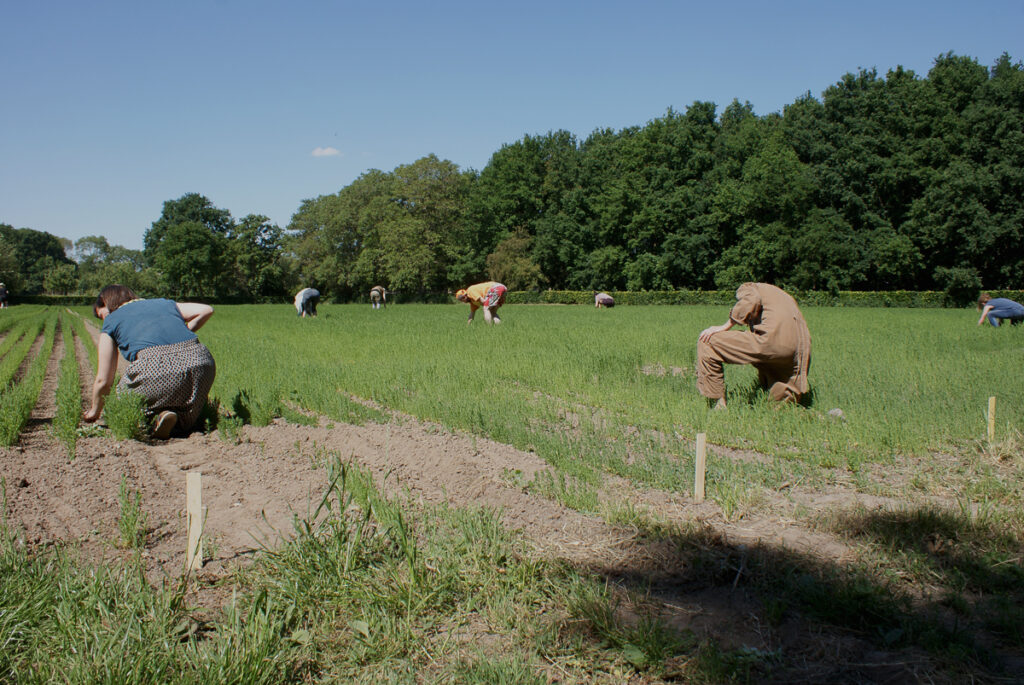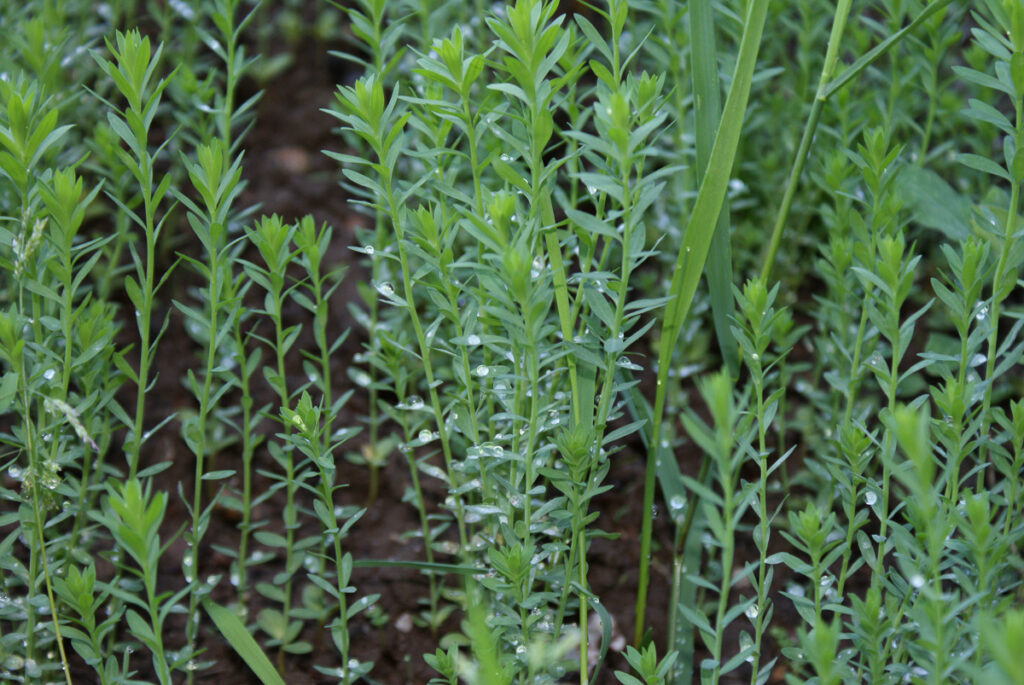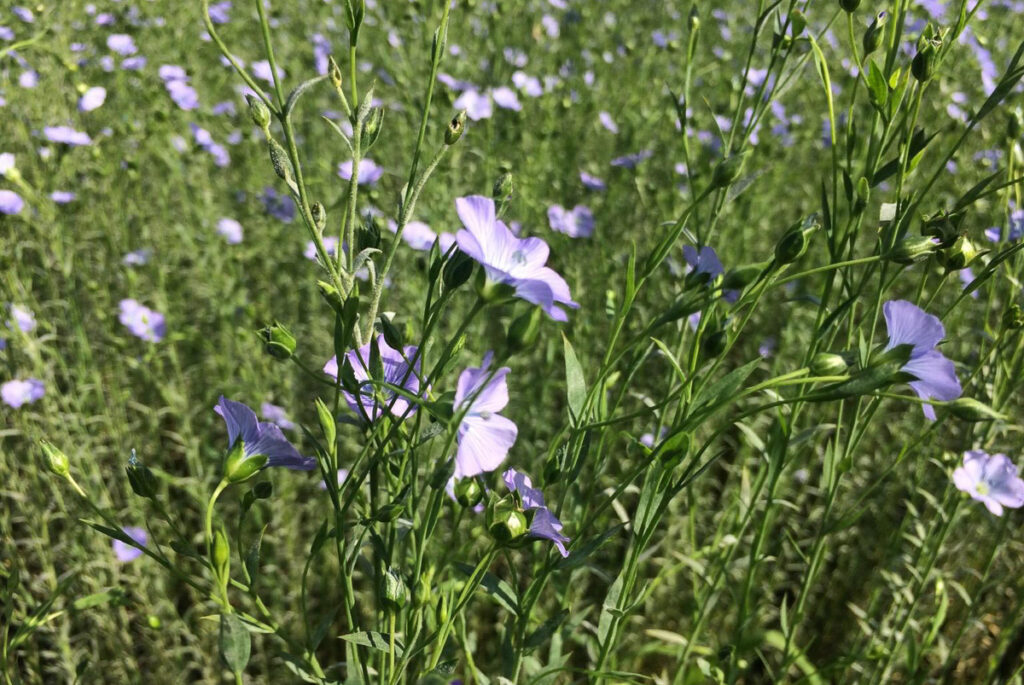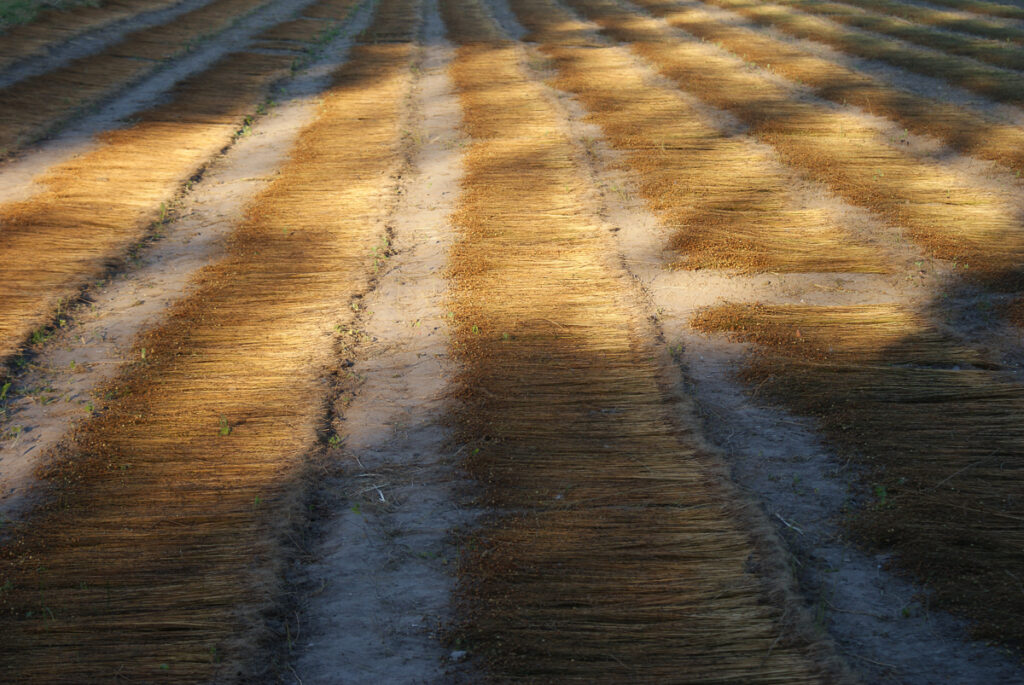- The Linen Project Shared Stewardship, Weeding the flax field by hand, 2020, photo: Rob Velker
- The Linen Project Shared Stewardship, Weeding the flax field by hand, 2020, photo: Rob Velker
- The Linen Project Shared Stewardship, Young flax plants, 2020, photo: Rob Velker
- The Linen Project Shared Stewardship, Flax field in bloom, 2020, photo: Rob Velker
- The Linen Project Shared Stewardship, Pulling the flax, 2020, photo: Rob Velker
- The Linen Project Shared Stewardship, Pulling the flax, 2020, photo: Rob Velker
- The Linen Project Shared Stewardship, Retting the flax, 2020, photo: Rob Velker
- The Linen Project Shared Stewardship, Turning the flax, 2020, photo: Heleen Klopper
Day by day encounters in collectively caring for the plants that will clothe us.
(A message to the reader in Dutch.)
(A message to the reader in English.)
The morning air hangs cool as we begin the harvest roughly 100 days after the flax was sown. Fellow linen stewards and members of our wider community gather, keen to get started. A thermos opens. The smell of coffee mingles with wet grass and sunscreen. We line up along the abundant field, bodies moving in sync, reaching close to the earth. Pulling handfuls of flax up from the soil, laying them on the cleared ground, spread evenly in rows, roots lined up for the processes to follow. Our activity is time-consuming and labour intensive compared with a machine harvest. It resonates with other values; being in connection with nature and with each other.
We first met on the field in the spring to weed, working on socks and barefoot so as not to crush the flax. Keen eyes seeking out that which is not. Picking our way through the rows, scanning, creeping forward, recognising trails of weeds and tread-marks as areas other stewards had covered. Moving around on the field, we get a feel for the shape of our community of linen stewards, the energy far surpassing the neat overview of tiny faces on our screens that we were starting to become accustomed to. Conversations chiming in with the wind and passing birds; voices on the periphery, concentration directed at the life emerging from the ground. A lively sense of spontaneity and curiosity meshes with a need for measurability and continuity.
We are learning by doing, with openness, willingness and respect for the fields we find ourselves on and in. Glancing up across the green plane, my gaze lands on silhouettes scattered against the sky; bent, hovering, crouching, balancing. Designers, makers, artists, artisans, educators, students, activists, researchers, enthusiasts. Our movements are isolated, slowed down, determined by the vulnerable young plants and their potential. Can we conceive that their fibres could one day clothe us? Slender stalks, luminous in the spring sunshine, stroke against our ankles as we weave between them.
Back on the field, the persistent onset of a summer heatwave has us facing the necessity of prioritising our wellbeing. We reluctantly cut the first day of the harvest short. The earthy scent of dirt, sweat and wilting vegetation lingers. I return at dusk with a fellow steward to replace the guide ropes for the following morning. Straddling the flax rows we wade down through the field in the dry heat, twine catching, seed pods rustling. How to respect and accept the conditions we encounter? We continue the harvest throughout the week, adjusting our presence on the field according to the weather.
A handful of stewards start at dawn, working until sheltering shadows disappear. Others work from late afternoon until sunset. We gather our available hours and energy in an effort to complete the harvest. An experienced ‘vlasser’ calls to see how we are doing; “our grandparents would be out there working all day, even with this heat, until all of the flax was pulled”. I catch myself wondering if 38-degree heat felt the same in 1940 as it does in 2020. It occurs to me that the summer break was enacted out of necessity, not for vacation; its timing coincides with the moment when all hands would be required on the fields. The harvest traditionally involved the entire village, with festivities coupled to its various stages. Given the current situation, we relish our breaks spread along the field’s edge, swapping insights with each other and inquisitive passers-by.
Cycling home, my muscles ache tellingly. I am struck by the intentionality of our activity: affording ourselves space and time to be present as stewards. The implication of labour, more so as the pandemic threatens to tighten its grip. What are the circumstances in which we show up? The weeding and harvest activities facilitate firsthand contact with the flax, the earth, and each other as a community. What would our absence mean? I consider the dialectic between labour and leisure that arises in my being a linen steward, alongside a growing consciousness of the fact that I do not currently rely on the flax for subsistence. As stewards, we share a commitment to explore and value the relationships we form together, giving shape to an alternative economic reality. With each new step, nature provides the measure. How do our actions resonate?
We leave the pulled flax out on the field, exposed to the elements. Bacteria activated by heat and moisture break down the pectin that binds the long fibres and the stem; a time-honoured process called dew retting. Three weeks later, a small group of stewards returns to turn the flax. A handful is tested, the woody basts crackling when wrung, revealing golden, rough-textured fibres. The envisioned outcome is fine, silvery strands. Timing is everything in this precarious and crucial stage of flax cultivation. Our close collaboration with the sun, the rain, the earth, the bacteria, the fibre, hangs in the balance. We have only just begun to experience what this means. Wait too long with bringing in the flax, and the fibre can become over-retted and weaken; act too soon and it will remain coarse. Another week passes. The call is made. Within 24 hours all available stewards gather on the field.
Members of our community are active throughout the final day, lifting the flax to air dry, then tying it in sheaves. I catch a ride to the field with co-stewards after work; there are still a few hours left till sundown. Joining in, rolling up the remaining flax rows; one, two, three steps form a sheaf. Kneeling down, near the ground again, the hues of the retted flax now merge with the soil. The thin, dry stalks appear brittle, but prove resilient as we pile our harvest into the rented truck. Climbing in on top to fit another layer, I am immersed in a heady mix of straw and dust. Stewards spread out across the field, flax passes quickly from hand to hand, contentment and anticipation buzzing as the final sheaves are brought in. We do a farewell lap in gratitude, taking in the sight of bare earth in the soft light of the gloaming.
Night falls and the flax is safely stored, awaiting the next interaction with the promise of the fibre that has been generated. Closely encountering its cultivation and the interconnected conditions throughout this cycle has affirmed a bond with the flax and our material origins. The fibre outcome, we soon learn, is symptomatic of a generally poor flax year. Acknowledging our shared commitment as stewards, can we embrace this as an invitation to reframe our expectations, to experiment, to adapt? Though not yielding the long strands we hoped for, there is much haptic and other knowledge to be gained. With the richness of skills and perspectives present in our community, we set out to reciprocate the contributed human and more than human energy in the processes that follow.
About Melanie Bomans
 Melanie Bomans currently lives in Arnhem, the Netherlands, where she is involved in The Linen Project; an initiative by ArtEZ MA Practice Held in Common and Crafts Council Nederland that investigates and works towards reactivating the economic viability of small-scale local flax cultivation and linen production. She is part of the project’s Shared Stewardship community, currently a group of thirty individuals – members of the local fashion and textile community, designers, makers, artists, artisans, farmers, researchers, students, activists, and flax and linen enthusiasts – who collectively share the care and responsibilities of the entire process from flaxseed to varying outcomes. You are invited to follow the project’s activities and progress on Instagram.
Melanie Bomans currently lives in Arnhem, the Netherlands, where she is involved in The Linen Project; an initiative by ArtEZ MA Practice Held in Common and Crafts Council Nederland that investigates and works towards reactivating the economic viability of small-scale local flax cultivation and linen production. She is part of the project’s Shared Stewardship community, currently a group of thirty individuals – members of the local fashion and textile community, designers, makers, artists, artisans, farmers, researchers, students, activists, and flax and linen enthusiasts – who collectively share the care and responsibilities of the entire process from flaxseed to varying outcomes. You are invited to follow the project’s activities and progress on Instagram.
Melanie describes herself as a translator. Her fashion practice engages dialogue–word, visual, material, garment, body–as a tool, a framework for understanding as well as manifesting. She considers translation as an act of inquiry; a process ‘in wording’, which in Dutch means a process in becoming, in taking shape. As a collaborator, educator, coordinator and editor, she is interested in relationships and how our interactions shape our world.









